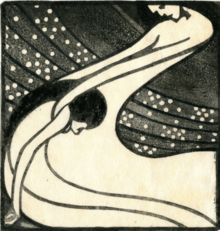Mileva Roller
Mileva Roller (February 18, 1886 – May 6, 1949) was an Austrian painter in the Viennese Secession movement.
Mileva Roller | |
|---|---|
.jpg) by Alfred Roller | |
| Born | Mileva Stojsavljevic 18 February 1886 |
| Died | 6 May 1949 (aged 63) |
| Nationality | Austria |
| Occupation | painter |
| Known for | involved in Viennese Secession movement |
| Spouse(s) | Alfred Roller |
Life
Mileva Stojsavljevic was born on 14 February 1886 in Innsbruck.[1] Her father, Milos Stojsavljevic, was a Serb from Velika Popina in Croatia, and her mother, Adelheid Hohenauer, was an Austrian porcelain painting teacher at the Vienna Women's Academy. Her younger brother, Raoul Stojsavljevic, was born in 1887 and he became a flying ace.
In 1906, she married the artist Alfred Roller.[2] They were both leading members of the Vienna Secession art movement and she, Koloman Moser, Gustav Klimt and Josef Hoffmann designed clothes for themselves and their families.[2]
Private life
She and Alfred had two sons Dietrich (1909-2001) who became a doctor and Ulrich (1911-1941) who became a stage designer and who, as an SS guard, died in Stolpovo near Kaluga (in the Soviet Union) during the Russian campaign at the end of 1941.[3]
Mileva has been described, by Brigitte Hamann, as 'an enthusiastically pro-Hitler Serbian'.[4] When Ulrich died on the Moscow front, Winifred Wagner wrote to Mileva, a woman she did not personally know:
The news has just reached me, though I cannot grasp it yet, that your dear son Uli has died a hero's death for his fatherland and his beloved Führer. I bow my head in silent respect for what you, his mother, must be going through...For us it is like losing a dear member of the family. (Bayreuth is in mourning) for the loss of such an extraordinarily gifted artist - whom Wieland had selected to be his eventual collaborator ...Now his young life has been fulfilled, and he died as he lived: believing in the Führer and the National Socialist ideal; believing in the great fatherland of the future. He was faithful unto death, and set a shining example to us all.[5]
In a later statement, the Roller family contradicted Winifred's opinion.[6]
Mileva Roller died in Vienna on 6 May 1949.[1] She was buried in Vienna Central Cemetery.

Legacy
Her work was included in the 2019 exhibition City Of Women: Female artists in Vienna from 1900 to 1938 at the Österreichische Galerie Belvedere.[7]
References
- "Ontdek schilder, tekenaar Mileva Roller". rkd.nl (in Dutch). Retrieved 2020-01-04.
- Houze, Rebecca (2017-07-05). "Textiles, Fashion, and Design Reform in Austria-Hungary Before the First World War ": Principles of Dress. Routledge. ISBN 978-1-351-54687-4.
- Nachlassverzeichnis Ulrich Roller
- Hamann, Brigitte (2005). Winifred Wagner: A Life At The Heart of Hitler's Bayreuth. Orlando: Harcourt Books. p. 339.
- Archiv der Republik, Vienna, directorate of State Opera, letter of 23.10.1940 quoted in Hamann, Brigitte (2005). Winifred Wagner: A Life At The Heart of Hitler's Bayreuth. Orlando: Harcourt Books. p. 339n.100.CS1 maint: multiple names: authors list (link)
- Statement by Prof. Dietrich Roller, March 1998 quoted in Hamann, Brigitte (2005). Winifred Wagner: A Life At The Heart of Hitler's Bayreuth. Orlando: Harcourt Books. p. 338n.101.
- "City of Women". Belvedere Museum Vienna. Retrieved 26 June 2020.
External links
